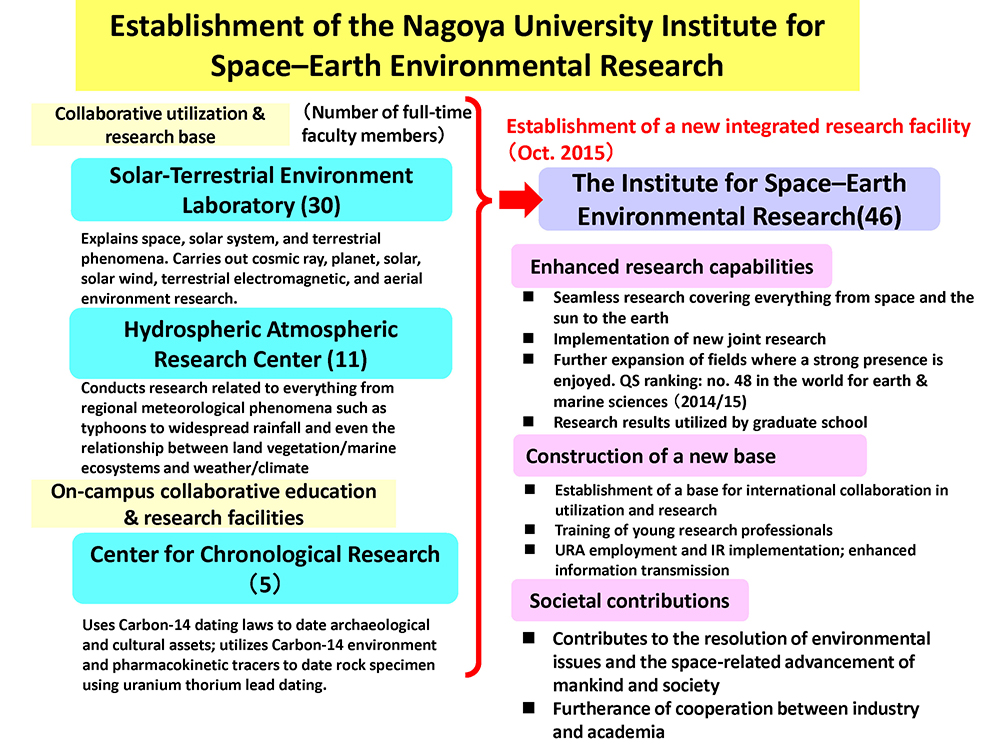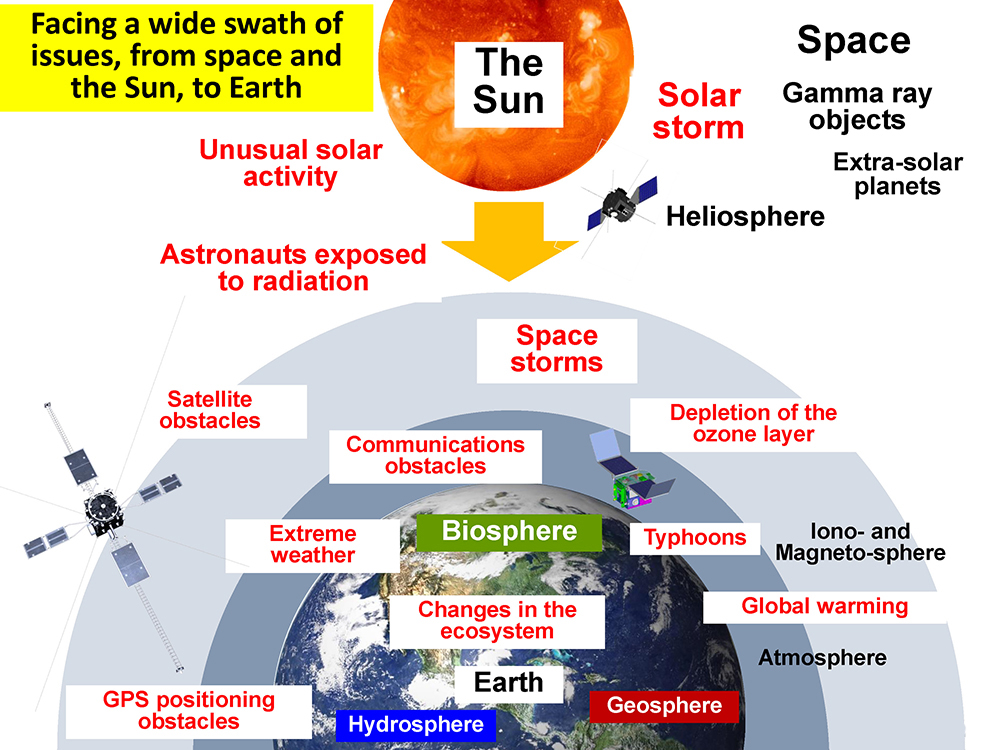About ISEE
Institute for Space-Earth Environmental Research
Nagoya University established a new research institute, the Institute for Space-Earth Environmental Research, on October 1, 2015, by integrating existing infrastructure in the form of the Solar-Terrestrial Environment Laboratory, the Hydrospheric Atmospheric Research Center (HyARC), and the Center for Chronological Research into a new research facility. By combining these three organizations, the university in effect created a new discipline in which relevant research is implemented ever more rigorously and in which more interdisciplinary research is carried out. The new research institute is recognized by the Ministry of Education, Culture, Sports, Science and Technology (MEXT) as a base of collaborative research and application. As the only research institute to tie together space and earth sciences, the Institute for Space-Earth Environmental Research treats the Earth, Sun, and universe as a single system. Through clarification of the diverse phenomena that occur in each of their mutual relationships, the Institute’s mission is to strive actively to resolve global environmental problems and to realize space-related advances to benefit humanity and society.
In an effort to realize this mission, the university has created and is implementing science to comprehensively understand interactive systems related to the cosmos, heliosphere, the ionosphere and magnetosphere, atmosphere, hydrosphere, biosphere, and geosphere. However, research on the global environment to date has not taken into account, to any significant extent, such space impacts as the influence on the global environment of changes in solar activity over the last 10 years. Moreover, research on the global environment in earth sciences has benefitted from advances in physics and chemical technologies as well as individual initiatives in ecology, physiology, and other biological sciences, with no integrated research framework for the global biosphere in existence. By integrating these three formerly independent organizations , the new institute is engaged in the seamless study of the cosmos, heliosphere, ionosphere and magnetosphere, atmosphere, hydrosphere, biosphere, and geosphere with the goal of clarifying the continuity of border regions and the interaction between domains.
The research institute is also hard at work clarifying issues challenging humanity. These include global warming and extreme weather such as typhoons and heavy rains; fine particulates (PM 2.5) and other forms of atmospheric and ocean pollution; depletion of the ozone layer, impediments to communications networks such as GPS and cell phone networks, and other electrical disturbances; disruptions caused by “killer electrons” from artificial satellites remaining from the early space age, and exposure of aircraft and astronauts to radiation. Meanwhile, the academic question of why the Earth became habitable, and just how it will change moving forward, is explained on a timescale ranging from a few decades to millions of years. Even as it answers the timeless questions of “where have we come from and where are we going,” the Institute is broadening the science that serves to stimulate the love and curiosity needed to search out universal as well as unknown physical and chemical laws.

In an effort to implement these in a straightforward manner, a Basic Research Department and Research Center Section was established under the auspices of the new institute. The Basic Research Department is made up of seven research divisions: the Division for Cosmic-Ray Research, the Division for Heliospheric Research, the Division for Ionospheric and Magnetospheric Environment, the Division for Meteorological and Atmospheric Research, the Division for Land-Ocean Ecosystem Research, the Division for Integrated Studies, and the Division for Chronological Research. Basic research in each specialty field is carried out within these divisions. Meanwhile, the Research Center Section is made up of three centers: the Center for International Collaborative Research, the Center for Integrated Data Science, and the Center for Orbital and Suborbital Observations.
The Institute holds faculty meetings to deliberate upon important matters related to the organization, human resources, research planning, budgets, and other administrative matters. There are also management conferences of professors from the new institute and from related graduate courses, with outside professionals representing related fields. The new Institute for Space-Earth Environmental Research is recognized as a base for cooperative use and research for Phase 3 intermediate objectives and mid-term plans. It works with related research institutes in Japan and overseas, to carry out its activities. It is for this reason that the Institute has established an operations committee, a collaborative research committee, a cooperative utilization and research committee, and other bodies made up mainly of outside experts.
With the structure outlined above, the Institute for Space-Earth Environmental Research is embarking on research projects that address issues transcending the following four areas: 1 the relationship between solar activity and climate change; 2 the relationship between the creation and transport of aerosols, including the effects of cosmic rays, and climate/ecosystems; 3 clarification of the various joint processes of the atmosphere, which mediate the relationship between atmospheric gravitational waves, high-energy particles, and plasma; and ④ the development of technology to predict large-scale disasters caused by solar activity, changes in the atmosphere and oceans, and the future state of space and the global environment. Moreover, the Institute also offers new support for international cooperation/large-scale collaborative utilization and collaborative research involving foreign nationals and international workshops. Through these it will promote collaborative international studies and contribute to the furtherance of international programs in related fields.
Through the four joint projects, the three centers, and the activities of the Basic Research Department mentioned above, the new institute is able to cooperate with relevant researchers from all over Japan as well as the world, including professionals from Europe and the US, Asia, and Africa. This potential for cooperation will be used to carry out joint research on space, solar, and earth systems, and to develop collaborative international research to resolve issues involving the global environment and utilization of space. These will include changes in the global environment as a result of solar activity, as well as predictions of space weather and extreme global weather. To that end, the support of everyone in our community is critical to realizing these initiatives. It is my hope that community members will give as much support to the Institute for Space-Earth Environmental Research as they have to our other facilities and past efforts.

<!–

–>


